Smarter Balanced Summative Assessment Results for ELA and Math
Smarter Balanced Summative Assessment Results Page
The group view provides an aggregate and individual display of a selected assessment for an assigned group, a custom group, or a school. Refer to the View Student Assessment Results by School and Grade section or the View Student Group Assessment Results section for details.
Once a user selects a summative assessment to display in the group view, the Results page displays as shown in figure 1.
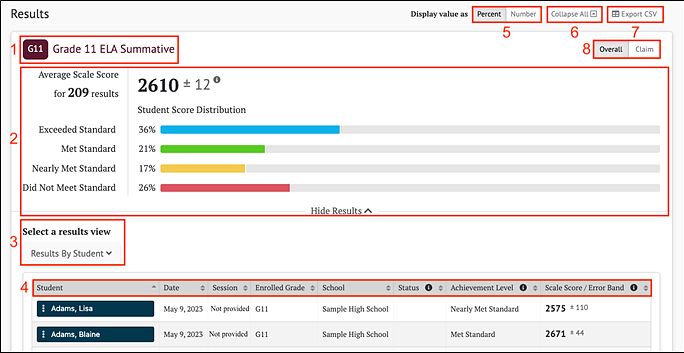
Figure 1. Summative Assessment Results page
The Results page for a Smarter Balanced summative assessment displays the following information and elements:
- Name and grade of the assessment
- Group Aggregate panel displays aggregate data for the selected group of students
- Select a results view drop-down menu offers the following options for display results:
- [Results By Student] (default view)
- [Writing Trait Scores] (for ELA only)
- [Target Report]
- [Lexile Report] (for ELA only) or [Quantile Report] (for math only)
- Results View table
- Display value as field: Contains toggles allowing a user to change the display to show the student score distribution in percentages of students or numbers of students in each reporting category
- [Collapse All] button: Hides the Results View table for all the displayed assessments and toggles to an [Expand All] button, which displays the results again
- [Export CSV] button: Gives the option to download the results in CSV format
- [Overall/Claim] toggle: Switches between Performance Scores Overall and Claim
- For Overall scores, the [Overall] toggle displays the Student Score Distribution with four achievement levels.
- For Claims, the [Claim] toggle displays four claims with three reporting categories.
Smarter Balanced Summative Assessment Group Results
The Smarter Balanced summative assessments report two performance scores: Overall and Claim. The [Overall] toggle displays the Student Score Distribution with four achievement levels, as shown in figure 2.
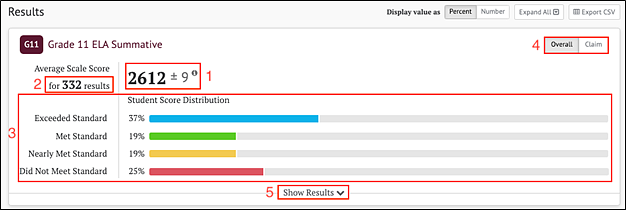
Figure 2. Overall Group Results for Smarter Balanced ELA Summative Assessment
The Group Aggregate panel for Smarter Balanced Overall Scores displays the following information and elements:
- Average Scale Score: Average scale score for the selected group of students and an error band based on the Standard Error of the Mean
- Number of student test results from which the average scale score and score distribution is calculated
- Student Score Distribution: Score distribution for the performance levels of the overall score
- [Overall/Claim] toggle: Switches between Performance Scores Overall and Claim
- [Show Results] button: Displays the Results View table for the displayed assessment and toggles to a [Hide Results] button that can hide the table
The [Claim] toggle displays four claims with three reporting categories, as shown in figure 3.

Figure 3. Claim Group Results for Smarter Balanced ELA Summative
The Group Aggregate panel for Smarter Balanced Claim Scores displays the following information and elements:
- Student Claim Level Distribution: Claim level distributions for the selected group of students
- [Overall/Claim] toggle: Switches between the Performance Scores Overall and Claim
- [Show Results] button: Displays the Results View table for the displayed assessment and toggles to a [Hide Results] button that can hide the table
Smarter Balanced Summative Assessment Results By Student
The Results View table for Smarter Balanced summative assessment results can be toggled to show Overall or Claim scores. Overall is the default selection.
Student Overall Scores
When the [Overall] button is selected, the Results By Student view includes the information elements for each student shown below.
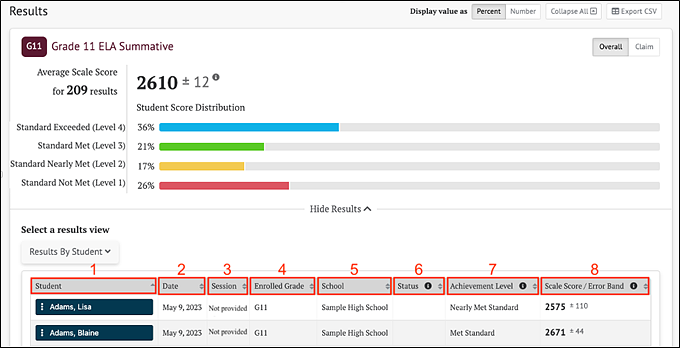
Figure 4. Summative Assessment Results By Student Overall Scores table
The Overall Score table includes the following information for each student:
- Student: Student’s full name and a Context Menu three dots icon [
 ] that provides access to additional student details (refer to Summative Student Options section)
] that provides access to additional student details (refer to Summative Student Options section) - Date: Date student completed the assessment
- Session: Testing session identifier (applicable to interim assessments only)
- Enrolled Grade: Student’s enrolled grade at the time of the assessment
- School: Student’s assigned school at the time of the assessment
- Status: The assessment status describes whether the administration condition (Manner of Administration) was Valid or Invalid. A blank Status field indicates a valid assessment status.
- Achievement Level: Student’s achievement level on the assessment: Did Not Meet Standard, Nearly Met Standard, Met Standard, or Exceeded Standard
- Scale Score/Error Band: Student’s scale score and score error band based on the Standard Error of Measurement (SEM) associated with that score
Student Claim Level Scores
When the [Claim] button is selected, the Results View panel changes to show each student’s assessment results by Claim, as shown below. Return to the default view by selecting the [Overall] button.
The Student Claim Level Distribution table displays the number or percent of students scoring in each reporting category (Below Standard, Near Standard, or Above Standard) for each claim.
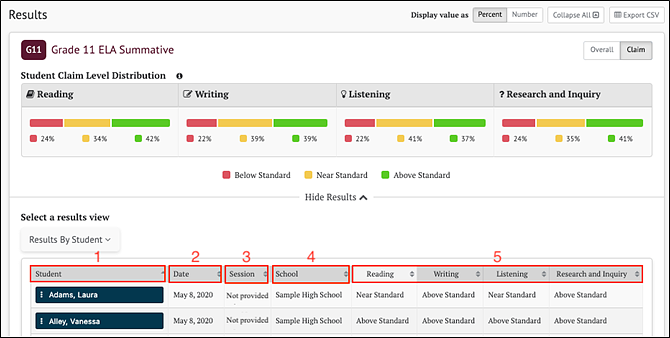
Figure 5. Summative Results By Student Claim Level Scores
Each student result in the Claim Scores table shows the following elements:
- Student: Student’s full name with a Context Menu three dots icon [
 ] provides access to additional student details (refer to Summative Student Options section)
] provides access to additional student details (refer to Summative Student Options section) - Date: Date student completed the assessment
- Session: Test session identifier (applicable to interim assessments only)
- School: Student’s assigned school at the time of the assessment
- Student performance on each claim is noted as Above Standard, Near Standard, or Below Standard for each of the assessment claims
Summative Student Options
When the Context Menu three-dot icon [ ] next to a student’s name is selected, the Student Options pop-up menu appears:
] next to a student’s name is selected, the Student Options pop-up menu appears:
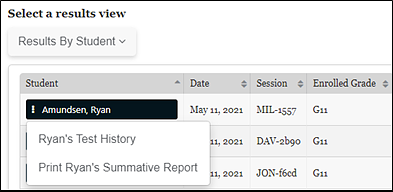
Figure 6. Student Options pop-up
The menu options for each student are:
[Test History]: Display the student’s test history. Refer to the Student Test History Report section for details.
[Print Summative Report]: Links to a printable Student Report (ISR) in PDF format. The selections already known in the context of the Summative results, such as the assessment type, subject, and school year, are auto-filled. Refer to the Printable Report section for details.
Smarter Balanced Summative Writing Trait Scores
The Writing Trait Scores view for Smarter Balanced ELA summative results displays a table of aggregate student results grouped by writing purpose (Argumentative, Explanatory, Informational, Narrative, or Opinion). Individual student writing trait scores are available in the Individual Student Report (ISR) PDF. Refer to the Printable Report section for details.

Figure 7. Writing Trait Scores table
A labeled tab displays for each writing task purpose that has student results. Selecting a purpose opens a table with aggregated student results.
- Each table row lists the category of writing performance, or writing trait (Evidence/Elaboration, Organization/Purpose, and Conventions), the group average and maximum points for that category, and the percentage/number of students who earned each number of points for that category.
- An [Export] button is available to export the results table to a CSV file. All available tabs will be included in the report.
Writing Extended Response (WER) Condition Codes for ELA
Writing Extended Response (WER) Condition Codes are used for responses to full-write essay items that cannot be scored because of the nature of the student’s response. A detailed description of each available condition code is provided in table 1.
When a student response is assigned a condition code, it is equivalent to a score of zero, with the exception of the “off purpose” code. In most cases, when a full-write response receives a condition code, that code is assigned to all three dimensions of the response. However, beginning with the 2022–23 test administration, if the condition code for a response is “off purpose,” only the evidence/elaboration and organization/purpose dimensions are assigned “off purpose,” and the conventions dimension is still scored. This conventions item score is included in the total ELA score and the writing claim score. The rule for “off purpose” scoring of conventions is applied regardless of the genre of the writing prompt.
| Condition Code | Description |
|---|---|
| Blank (B) | Student did not enter a response. |
| Insufficient (I) |
Student has not provided a meaningful response; examples can include
For ELA full-writes, responses previously described and if the student’s original work is insufficient to determine whether the student is able to organize, cite evidence and elaborate, and use conventions as defined in the rubrics; or the response is too brief to determine whether it is on purpose or on topic. |
| Non-scorable Language (L) |
ELA: language other than English Mathematics: language other than English or Spanish |
| Off Topic (T) |
For ELA Full-Writes Only A writing sample will be judged as off-topic when the response is unrelated to the task or the sources or shows no evidence that the student has read the task or the sources (especially for informational/explanatory and opinion/argumentative). Off-topic responses are generally substantial responses. |
| Off Purpose (M) |
For ELA Full-Writes Only A writing sample will be judged as off-purpose when the student has clearly not written to the purpose designated in the task. An off-purpose response addresses the topic of the task but not the purpose of the task. Off-purpose responses are generally developed responses (essays, poems, etc.) clearly not written to the designated purpose. If the condition code for a response is “off purpose,” only the evidence/elaboration and organization/purpose dimensions are assigned “off purpose,” and the conventions dimension is still scored. |
Smarter Balanced Summative Target Reports
Each Smarter Balanced Claim for English language arts/literacy and mathematics includes a set of assessment targets that provide more detail about the expectations of the knowledge, skills, and/or abilities assessed by the items and tasks within each claim. For the summative assessment, target-level scores are calculated for each English language arts/literacy claim. For mathematics, target-level scores are calculated for Claim 1 only. CERS displays aggregate target-level reports for each summative assessment. Target scores are reported as Performance Relative to the Entire Test and Performance Relative to Level 3 (Standard Met).
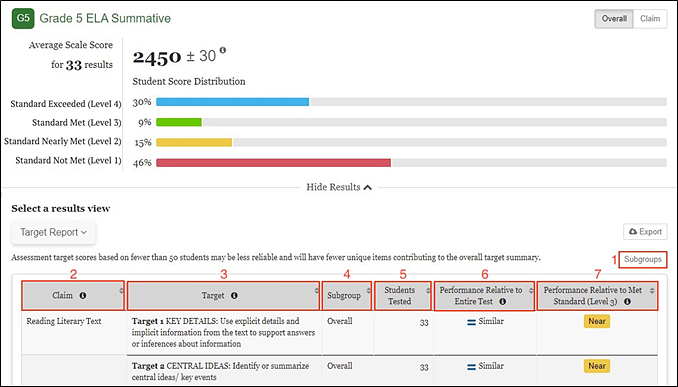
Figure 8. Target Report page
The Target Report table includes the following information:
- [Subgroups] button: Disaggregate the target report by student demographic or program group
- Claim: The Claim(s) associated with the assessment subject
- Target: The Targets associated with each Claim
- Subgroup: The student subgroup breakdown of the report
- Students Tested: The number of students who answered questions related to the target
- Performance Relative to Entire Test: The overall student Performance Relative to the Entire Test (Better, Similar, or Worse)
- Performance Relative to Met Standard (Level 3): The overall student Performance Relative to Level 3 (Below, Near, or Above)

Figure 9. Target Report table indicators
Performance Relative to the Entire Test
Performance Relative to the Entire Test is reported in one of three reporting categories: Better, Similar, or Worse. This report indicates whether students' performance on a target was better than, the same, or worse than the students' performance on the entire test. A "Worse" indicator does not necessarily mean poor performance on a target, but rather that students' performance in this area was weaker than the overall performance.
Performance Relative to Level 3
Performance Relative to Level 3 (Met Standard) is reported in one of three reporting categories: Above, Near, or Below. This report Indicates whether students' performance on a target was above, near, or below the performance standard (Level 3: Met Standard). A "Below" indicator suggests that students have not yet mastered the content assessed in a target; however, the students' overall performance on the test may be near or above standard.
Lexile and Quantile Measures
Lexile and Quantile measures and ranges are derived from student scores on the Smarter Balanced ELA and mathematics assessments.
Lexile Measures for ELA
Lexile Measures in Group View
The group view provides an individual display of Lexile measures and Lexile ranges for an assigned group, a custom group, or a school. Refer to the View Student Assessment Results by School and Grade section or the View Student Group Assessment Results section for details. Once a user selects an ELA summative assessment to display in the group view, the Results page displays as shown in figure 10.
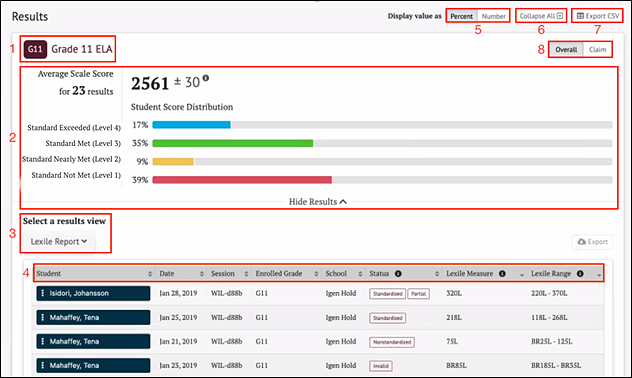
Figure 10. Lexile Report display
The Results page for a Smarter Balanced summative assessment displays the following information and elements:
- The name and grade of the assessment
- The Group Aggregate Panel displays aggregate data for the selected group of students
- The Select a results view drop-down menu offers the following options for display results:
- [Results by Student] (default view)
- [Writing Trait Scores]
- [Target Report]
- [Lexile Report]
- The Results View table
- The Display value as field contains toggles allowing a user to change the display to show the student score distribution in percentages of students or numbers of students in each reporting category
- The [Collapse All] button, which hides the Results View table for all the displayed assessments and toggles to an [Expand All] button, which displays the results again
- The [Export CSV] button, which gives the option to download the results in CSV format
- Toggle buttons to switch between Performance Scores: [Overall] and [Claim]
- For Overall scores, the [Overall] toggle displays the Student Score Distribution with four achievement levels
- For Claims, the [Claim] toggle displays four claims with three reporting categories
Select a results view for the Lexile Report
Per figure 11 (below), when the Select a results view drop-down is selected, the Select a results view options appears:
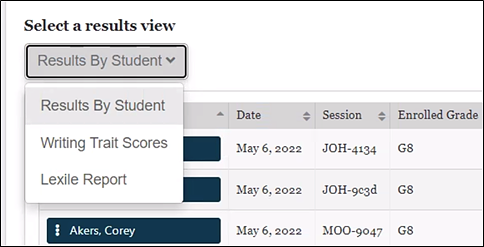
Figure 11. Select a results view for the Lexile Report
The options for each student are:
- [Results by Student] (default view)
- [Writing Trait Scores]
- [Lexile Report]
Lexile Measure and Lexile Range
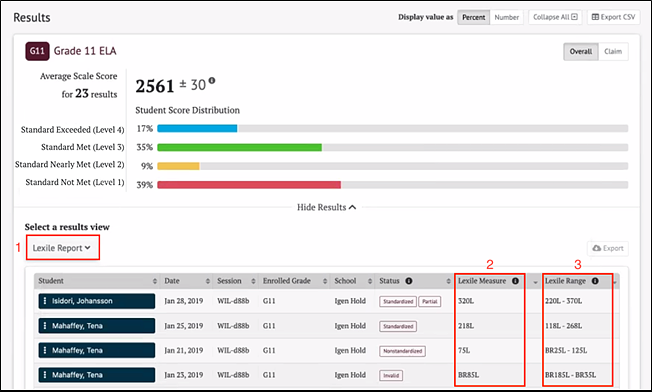
Figure 12. Lexile Measure and Range view
- The Select a results view drop-down menu offers the following options for display results:
- [Results By Student]
- [Writing Trait Scores]
- [Target Report]
- [Lexile Report]
- Lexile Measure: A student’s Lexile measure represents the student’s ability to read independently on a scale from below 0L to above 1600L.
- Lexile Range. A student’s Lexile range is 50L above and 100L below the student’s Lexile measure.
Lexile Measures By Student
The Results By Student table includes the information elements for each student shown below.
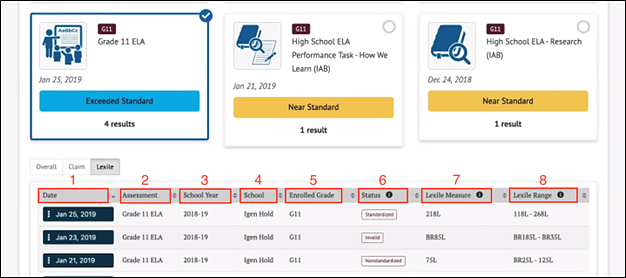
Figure 13. Lexile Measures By Student
The Overall Score table includes the following information for each student:
- Date: Date student completed the assessment
- Assessment: Name of Assessment
- School Year: School year for assessment
- School: Student’s assigned school at the time of the assessment
- Enrolled Grade: Student’s enrolled grade at the time of the assessment
- Status: For interim assessments, assessment status includes whether the assessment administration (Manner of Administration) was Standardized or Nonstandardized, or if the assessment was marked Partial or Complete (Completeness). For summative assessments, assessment status only includes whether the assessment administration (Manner of Administration) was Valid or Invalid. An empty field for a summative assessment indicates a valid assessment status.
- Lexile Measure: A student’s Lexile measure represents the student’s ability to read independently on a scale from below 0L to above 1600L.
- Lexile Range. A student’s Lexile range is 50L above and 100L below the student’s Lexile Measure.
Quantile Measures for Math
Quantile Measures in Group View
The group view provides an individual display of Quantile measure and Quantile range for an assigned group, a custom group, or a school. Refer to the View Student Assessment Results by School and Grade section or the View Student Group Assessment Results section for details. Once a user selects a Smarter Balanced Math summative assessment to display in the group view, the Results page displays as shown in figure 14.
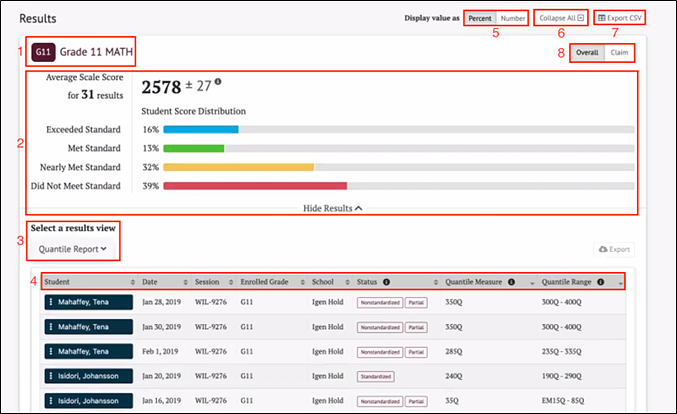
Figure 14. Quantile Report display
The Results page for a Smarter Balanced summative assessment displays the following information and elements:
- The name and grade of the assessment
- The Group Aggregate Panel displays aggregate data for the selected group of students
- The Select a results view drop-down menu offers the following options for display results:
- [Results by Student] (default view)
- [Target Report]
- [Quantile Report]
- The Results View table
- The Display value as field contains toggles allowing a user to change the display to show the student score distribution in percentages of students or numbers of students in each reporting category
- The [Collapse All] button, which hides the Results View table for all the displayed assessments and toggles to an [Expand All] button, which displays the results again
- The [Export CSV] button, which gives the option to download the results in CSV format
- Toggle buttons to switch between Performance Scores: [Overall] and [Claim]
- For Overall scores, the [Overall] toggle displays the Student Score Distribution with four achievement levels
- For Claims, the [Claim] toggle displays four claims with three reporting categories
Select a results view for the Quantile Report
Per figure 15 (below), when the Select a results view drop-down is selected, the Select a results view options appears:
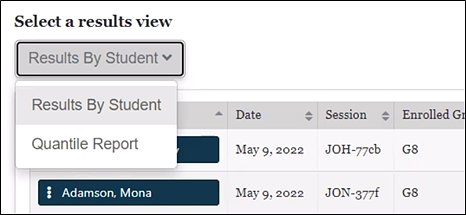
Figure 15. Select a results view for the Quantile Report
The options for each student are:
- [Results by Student] (default view)
- [Quantile Report]
Quantile Measure and Quantile Range
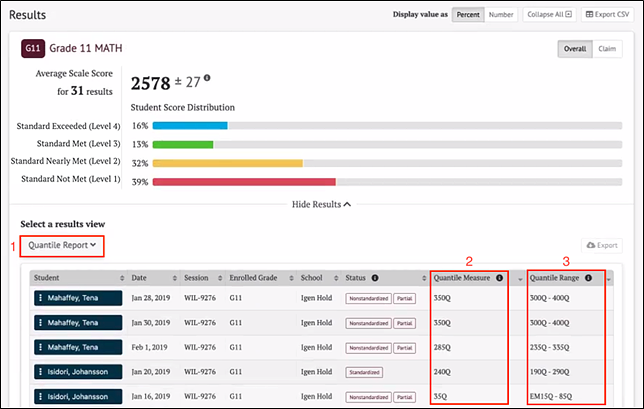
Figure 16. Quantile Measure and Range view
- The Select a results view drop-down menu offers the following options for display results:
- [Results By Student]
- [Target Report]
- [Quantile Report]
- Quantile Measure: A student’s Quantile measure represents the student’s readiness for mathematics instruction on a scale from below 0Q to above 1600Q.
- Quantile Range. A student’s Quantile range is 50Q above and 50Q below the student’s Quantile measure.
Quantile Measures By Student
The Results By Student table includes the information elements for each student shown below.
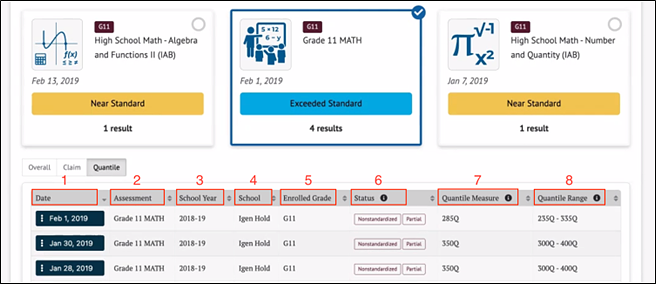
Figure 17. Quantile Measures By Student
The Overall Score table includes the following information for each student:
- Date: Date student completed the assessment
- Assessment: Name of Assessment
- School Year: School year for assessment
- School: Student’s assigned school at the time of the assessment
- Enrolled Grade: Student’s enrolled grade at the time of the assessment
- Status: For interim assessments, assessment status includes whether the assessment administration (Manner of Administration) was Standardized or Nonstandardized, or if the assessment was marked Partial or Complete (Completeness). For summative assessments, assessment status only includes whether the assessment administration (Manner of Administration) was Valid or Invalid. An empty field for a summative assessment indicates a valid assessment status.
- Quantile Measure: A student’s Quantile measure represents the student’s readiness for mathematics instruction on a scale from below 0Q to above 1600Q.
- Quantile Range. A student’s Quantile range is 50Q above and 50Q below the student’s Quantile measure

